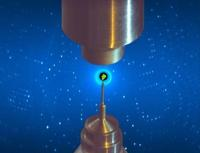Speaker
Description
Daniele Di Bari1,2,3, Stepan Timr4, Fabio Sterpone4, Alessandro Paciaroni1, Judith Peters2,3.
1Univ. of Perugia, Dep. of Physics and Geology, Italy. 2Univ. Grenoble-Alpes, CNRS, LiPhy, France. 3Institut Laue-Langevin, France. 4Laboratoire de Biochimie Theorique, CNRS, France.
Life on Earth exhibits an amazing adaptive capacity to a vast range of temperatures. While the molecular mechanisms underlying such adaptability are not yet fully understood, it has been proposed that the temperature of cellular death coincides with a catastrophic denaturation of the proteome. Here we combine incoherent quasi-elastic and elastic neutron scattering experiments with multi-scale molecular dynamics simulations to describe the dynamical features of the proteins in the E. Coli cytoplasm when approaching thermal denaturation, and to characterize distinct contributions to their pico- to nanosecond dynamics. Moreover, we test the validity of the Lindemann criterion — linking structural fluctuations and melting — in cell-like conditions.
Our results allow us to rationalize the existence of a specific dynamical regime revealed by neutron scattering experiments to be a general signature around cell-death temperature.

